语言学填空题
语言学 填空题
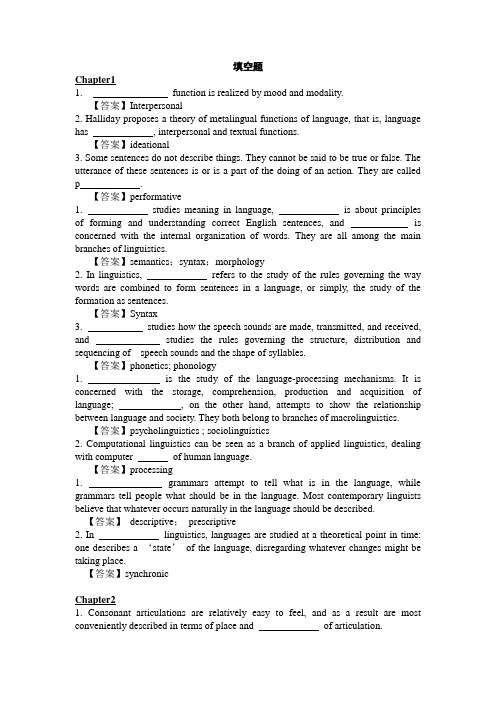
填空题Chapter11. function is realized by mood and modality.【答案】Interpersonal2. Halliday proposes a theory of metalingual functions of language, that is, language has , interpersonal and textual functions.【答案】ideational3. Some sentences do not describe things. They cannot be said to be true or false. The utterance of these sentences is or is a part of the doing of an action. They are called p .【答案】performative1. studies meaning in language, is about principles of forming and understanding correct English sentences, and is concerned with the internal organization of words. They are all among the main branches of linguistics.【答案】semantics;syntax;morphology2. In linguistics, refers to the study of the rules governing the way words are combined to form sentences in a language, or simply, the study of the formation as sentences.【答案】Syntax3. studies how the speech sounds are made, transmitted, and received, and studies the rules governing the structure, distribution and sequencing of speech sounds and the shape of syllables.【答案】phonetics; phonology1. is the study of the language-processing mechanisms. It is concerned with the storage, comprehension, production and acquisition of language; , on the other hand, attempts to show the relationship between language and society. They both belong to branches of macrolinguistics.【答案】psycholinguistics ; sociolinguistics2. Computational linguistics can be seen as a branch of applied linguistics, dealing with computer of human language.【答案】processing1. grammars attempt to tell what is in the language, while grammars tell people what should be in the language. Most contemporary linguists believe that whatever occurs naturally in the language should be described.【答案】descriptive;prescriptive2. In linguistics, languages are studied at a theoretical point in time: one describes a ‘state’of the language, disregarding whatever changes might be taking place.【答案】synchronicChapter21. Consonant articulations are relatively easy to feel, and as a result are most conveniently described in terms of place and of articulation.【答案】manner2. are produced by constricting or obstructing the vocal tract at some place to divert, impede, or completely shut off the flow of air in the oral cavity.【答案】consonantsChapter31. There are two fields of morphology: the study of and the study of .【答案】inflectional;lexical/derivational2. A morpheme is one that cannot constitute a word by itself.【答案】bound3. is a branch of linguistics that studies the interrelationship between phonology and morphology.【答案】Morphophonology1. is a relatively complex form of compounding in which a new word is formed by joining the initial part of one word and the final part of another word. For example, the English word smog is made from and .【答案】blending;smoke;fog2. The principle of Creation can account for the co-existence of two forms, regular and irregular, in the conjugation of some English verbs.【答案】Analogical3. Back-formation refers to an abnormal type of word-formation where a shorter word is derived by deleting an affix from a longer form already in the language.【答案】imaginedChapter41.______ refers to ties and connections which exist within texts. They are also called formal links between sentences and between clauses.【答案】CohesionChapter51. According to G Leech, meaning is the communicative value an expression has by virtue of what it refers to, over and above its purely conceptual content【答案】connotative2. According to G. Leech, meaning refers to what is communicated of the feelings and attitudes of the speaker/writer.【答案】affective1.“X buys something from Y”and “Y sells something to X”are in a relation of .【答案】converse antonymy2. Terms like “desk”and “stool”are of the term “furniture”.【答案】(co-)hyponyms3.“Tulip”, “rose”and “violet”are all included in the notion of “flower”. Therefore, they are superordinates of “flower”【答案】FChapter91. “The world is like a stage” is an example of, and “All the world is a stage”is an example of . They are often used in analyzing features of literary language.nnn【答案】simile;metaphor1. At different times, different patterns of metre and sound have developed and become accepted as ways of structuring poems. Among them, consists of lines in iambic pentameter which do not rhyme.【答案】blank verse2. A foot contains two syllables. A stressed syllable comes first, following by an unstressed syllable.【答案】trochee。
语言学考试题库及答案
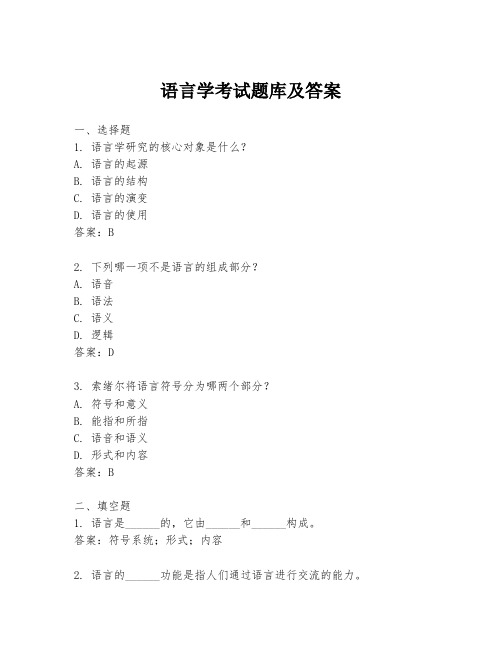
语言学考试题库及答案一、选择题1. 语言学研究的核心对象是什么?A. 语言的起源B. 语言的结构C. 语言的演变D. 语言的使用答案:B2. 下列哪一项不是语言的组成部分?A. 语音B. 语法C. 语义D. 逻辑答案:D3. 索绪尔将语言符号分为哪两个部分?A. 符号和意义B. 能指和所指C. 语音和语义D. 形式和内容答案:B二、填空题1. 语言是______的,它由______和______构成。
答案:符号系统;形式;内容2. 语言的______功能是指人们通过语言进行交流的能力。
答案:交流3. 语言的______功能是指语言能够表达思想和情感的能力。
答案:表达三、简答题1. 简述语言和言语的区别。
答案:语言是指一种抽象的符号系统,它包括语音、语法、语义等规则和结构;言语则是指个人使用语言进行交流的具体行为。
2. 描述索绪尔的“能指”和“所指”概念。
答案:索绪尔认为语言符号由“能指”和“所指”两部分组成。
“能指”指的是语言符号的声音形式,而“所指”指的是符号所代表的概念或意义。
四、论述题1. 论述语言的任意性原则及其对语言学习和教学的影响。
答案:语言的任意性原则指的是语言符号的声音形式和它所代表的概念之间没有必然的联系。
这一原则对语言学习和教学有着深远的影响,因为它意味着学习者需要记忆每个符号的声音和意义之间的联系,而不能依赖于逻辑或直观的关联。
这对语言教学提出了挑战,要求教师设计有效的教学方法来帮助学生记忆和理解这些任意的联系。
2. 分析语言的交际功能及其在现代社会中的重要性。
答案:语言的交际功能是指语言作为交流工具,使人们能够传递信息、表达情感和进行社会互动。
在现代社会,随着全球化和信息技术的发展,语言的交际功能变得尤为重要。
有效的沟通能够促进国际合作、文化交流和商业交易,同时也有助于解决社会冲突和增进理解。
因此,掌握一门或多门语言对于个人和社会的发展至关重要。
语言学概论试题(13)
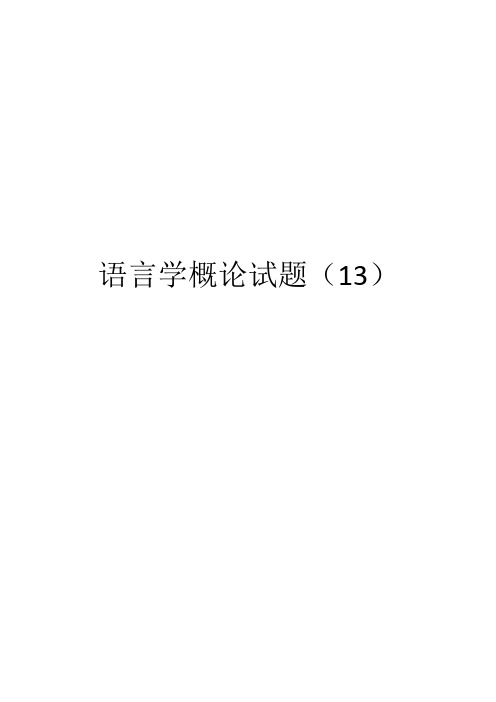
语言学概论试题(13)一、填空题(每空0.5分,共10分)1.中国的传统语言学过去称为(小学),包括三门学科:(文字学)、(音韵学)、(训诂学)。
2.结构主义语言学是指20世纪以(索绪尔)(语言学家名字)的语言学理论为代表以及受这种理论的影响而进行的语言理论研究。
1916年,他的(《普通语言学教程》)出版,标志着结构主义语言学的诞生。
3.语言符号有两个最基本的特点,一是(任意)性,二是(线条)性。
4.人类的发音器官分为三大部分:动力部分是(肺),发音体是(声带),共鸣腔包括(口腔)、(鼻腔)、(咽腔)。
5.请用国际音标写出八个基本元音:[i]、[e]、[]、[a]、[u]、[o]、[]、[]。
6.南京方言的“兰”、“南”不分,从音位变体的角度来说,[n]和[l]是属于(自由)变体。
7.词的结构类型体现了词的(组合)关系,最常见最基本的结构类型有(主谓)、(述宾)、(述补)、(偏正)、(联合)五种。
8.句式变换常使用的手段有(成分移位)、(增添成分)、(省略成分)、改变语调四种。
二、判断题(每题1分,共10分)1.非音质音位没有区别词的语音形式的作用。
(×)2.[a]、[A]、[]、[]是汉语普通话中同一个音位的四个自由变体。
(×)3.双语现象的出现是语言融合过程中重要的、富有特征性的现象,是两种或几种语言统一为一种语言的必经的过渡阶段。
(√)4.社会的分化是产生地域方言或亲属语言的社会原因,语言发展的不平衡性是产生地域方言和亲属语言的语言内部原因。
(√)5.在语言发展中,词汇发展最快,语音发展最慢。
(×)6.语言发展最基本的条件是语言内部各要素的影响。
(×)7.音位是所有语言都统一的,都是跨语言或跨方言的。
(×)8.音素是从音色角度划分出来的最小的语音单位。
同样一个音素,就其自然属性,对各个语言来说都是一样的。
(√)9.新词的产生和旧词的消亡是语言词汇发展的两项重要内容。
语言学纲要练习题:绪论

绪论一、填空题1.语言学是研究语言的科学,(语言)是语言学的研究对象。
语言学的基本任务是研究(语言)的规律,使人们懂得关于(语言)的理性知识。
2.(中国)(印度)(希腊-罗马)具有悠久的历史文化传统,是语言学的三大发源地。
3.我国传统语文学包括(文字学)(音韵学)(训诂学)等三门分支学科,合称“小学”。
4.人类对语言的研究大体上可分为(语文学)阶段(历史比较语言学)阶段(结构主义语言学)阶段、形式语言学阶段、交叉语言学阶段。
5.历史比较语言学的先驱人物是威廉·琼斯;草创者是施列格尔;奠基人物是拉斯克、(博普)、格林。
6.在19世纪逐步发展和完善起来的(历史比较语言学)不但宣告语言学的真正独立,而且为普通语言学的研究奠定了基础。
7.普通语言学的奠基人物是(索绪尔)和洪堡特。
前者所著(《普通语言学教程》)在语言学发展史上起到了划时代的作用。
8.结构主义语言学派可以分为三派。
它们分别是(布拉格学派)(哥本哈根学派)(美国描写语言学派)。
9.形式语言学的主要代表人物是(乔姆斯基),他认为对语言进行描写和分析的目的在于研究人的语言生成能力。
他的目标是建立一个能产生所有句子的语法系统。
10.新时期语言学的最大特点是(交叉性)(边缘性)。
11.(文言)是我国古代的书面语,用它写成的文章称为(文言文)。
12.研究语言的结构,主要是研究(语音)(词汇)(语义)(语法)四个部分。
13.运用语言传递信息的过程,可以分为(编码)(发送)(传递)(接收)(解码)五个阶段。
二、判断题(正确的打√,错误的打x)(×)1.综合各种语言基本研究成果,归纳成语言一般规律,这是具体语言学的任务。
(√)2.世界上有几千种语言,有些语言的研究已经比较深入,大部分语言的研究还很不够,甚至还没有人去研究。
(√)3.语言学既是一门古老的科学,又是一门年轻的科学;既与社会科学有密切的关系,又与自然科学有密切的关系。
(×)4.我国的语言研究基本上是在洋务运动后走上独立发展的道路的。
语言学:语言学概论考试试题

语言学:语言学概论考试试题1、填空题语言学的三大发源地:()正确答案:中国、印度、希腊—罗马2、名词解释语言融合正确答案:是指某个民族或某个民族中一部分人放弃本民族的语言而专用其他民族的语言,一种语言取代其(江南博哥)他语言,成为不同民族共同的交际工具,又叫语言转用、语言同化或语言替换。
3、多选下列有关普通话的表述中,正确的有()A.以北京语音为标准音B.以北京话为基础方言C.以北方方言为基础方言D.以典范的现代白话文著作为语法规范E.以历代经典的文学作品为语法规范正确答案:A, C, D4、名词解释通语正确答案:或称凡语、凡通语、通名等,是杨雄《方言》一书用来指西汉时没有地域限制,通行比较广的共同语的术语。
5、名词解释词汇意义(词义)正确答案:由人们对现实现象的反映以及由此带来的人们对现实现象的主观评价。
词典的释义所说明的一般都是词的词汇意义。
6、填空题根据语言的亲属关系对语言的分类叫做(),也叫做()。
正确答案:语言的谱系分类、语言的发生学分类7、单选下面词组中,结构类型与其他各组不同的一组是()A.年轻漂亮/朴素大方B.我们大家/首都北京C.铁路民航/工人农民D.贯彻执行/讨论研究正确答案:B8、名词解释社会语言学正确答案:用社会学的方法研究社会上的形形色色的语言变异等问题9、问答题简答复元音与几个相连的单元音的区别。
正确答案:复元音的几个成分同属于一个音节,发音时发音器官只有一次肌肉紧张;相连的单元音则各自分属于不同的音节,发音时有几个元音就有几次肌肉紧张;复元音是一个整体,发音时发音器官的运动是连续滑动的,元音的音质是不间断地逐渐变化的,中间会产生一连串的过渡音。
几个相连的单元音是彼此独立的整体,发音时发音器官的运动是跳跃式的,元音的音质是突变的,中间没有过渡音。
10、填空题句子结构关系的意义可以分为()意义和()意义两种。
正确答案:显性;隐性11、名词解释单纯字符正确答案:不能再分解为更小字符的字符。
语言学第二章习题
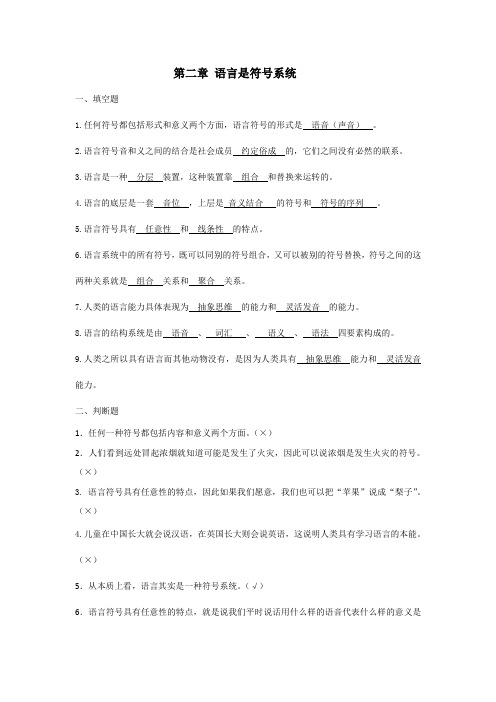
第二章语言是符号系统一、填空题1.任何符号都包括形式和意义两个方面,语言符号的形式是语音(声音)。
2.语言符号音和义之间的结合是社会成员约定俗成的,它们之间没有必然的联系。
3.语言是一种分层装置,这种装置靠组合和替换来运转的。
4.语言的底层是一套音位,上层是音义结合的符号和符号的序列。
5.语言符号具有任意性和线条性的特点。
6.语言系统中的所有符号,既可以同别的符号组合,又可以被别的符号替换,符号之间的这两种关系就是组合关系和聚合关系。
7.人类的语言能力具体表现为抽象思维的能力和灵活发音的能力。
8.语言的结构系统是由语音、词汇、语义、语法四要素构成的。
9.人类之所以具有语言而其他动物没有,是因为人类具有抽象思维能力和灵活发音能力。
二、判断题1.任何一种符号都包括内容和意义两个方面。
(×)2.人们看到远处冒起浓烟就知道可能是发生了火灾,因此可以说浓烟是发生火灾的符号。
(×)3.语言符号具有任意性的特点,因此如果我们愿意,我们也可以把“苹果”说成“梨子”。
(×)4.儿童在中国长大就会说汉语,在英国长大则会说英语,这说明人类具有学习语言的本能。
(×)5.从本质上看,语言其实是一种符号系统。
(√)6.语言符号具有任意性的特点,就是说我们平时说话用什么样的语音代表什么样的意义是自由的,不受任何约束。
(×)7.语言符号可以拆卸拼装,重复使用。
(√)8.语言符号系统是由大大小小的单位随意构成的。
(×)9.通过符号的任意性特点,我们可以解释为什么人类社会有各种各样的语言。
(√)10.语言系统是由不同层级构成的,低一级的单位少,组成高一级后数量翻番。
(√)11.鹦鹉、八哥都会说话,有的甚至还会背古诗,可见,动物也有语言能力。
(×)12.语言是人类和其他动物相区别的标志之一。
(√)13.动物掌握“语言”是先天的本领,人类掌握语言则需要后天的学习。
(√)14.符号,简单地说,就是征候。
语言学填空

一、单项选择题1.关于“语言”的定义,下列说法不正确的一项是BA.语言是一种社会现象B.语言就是人们说出来的话C.语言的客观存在形式首先是有声的口头语言D.语言是一个符号系统2.关于“言语活动”、“语言”和“言语”三者之间的关系,下列说法不正确的一项是C A.“语言”等于“言语活动”减去“言语”B.“语言”是主要的,而“言语”是次要的C.“言语”是“言语活动”中的社会部分D.“语言”是从“言语活动”抽象出来的一个均质的系统3.索绪尔创立的语言学可以称为CA.传统语言学B.历史比较语言学C.结构主义语言学D.社会语言学4.从音质角度划分出来的最小语音单位是BA.音渡B.音素C.音位D.音节5.[p…]的发音特征是AA.双唇送气清塞音B.双唇不送气清塞音C.舌尖前送气清塞音D.舌尖前不送气清塞音7.说话人根据表达需要有意识地加上去的句重音是DA.节律重音B.语法重音C.固定重音D.强调重音8.下列关于语汇的表述中,正确的一项是DA.语汇是有意义的能独立使用的语言单位B.语汇是最小的有意义的语言单位C.语汇是固定词组和熟语的总汇D.语汇是一种语言中词和语的总和9.从词的构造方式看,汉语“健儿”一词属于CA.单纯词B.派生词C.复合词D.简缩词10.下列各个汉语词语中的“子”是词根语素的是CA.笼子B.鸽子C.瓜子D.日子11.下列关于语法的表述中,不正确的一项是CA.语法是关于词的构成变化和词构成词组和句子的规则B.语法是说本族语的人的直觉知识和约定习惯C.语法是与语音、语汇等要素互不相关的规则D.语法是与语音、语汇等相比变化较慢的现象13.下列关于词义模糊性的表述中,正确的一项是AA.词义所指范围边缘区域模糊,中心区域明确B.词义所指范围边缘区域明确,中心区域模糊C.词义所指范围边缘区域、中心区域都模糊D.词义所指范围边缘区域可能模糊14.“哈巴狗”和“狮子狗”指的是同一种狗,二者在词义上的主要差别是C A.理性意义不同B.语体色彩不同C.形象色彩不同D.语气意义不同15.下列各项中,含有降级述谓结构的是CA.他申请去北京进修B.你去请他比较好C.他取下了挂在墙上的地图D.他害怕老师批评他16.下列各项中,甲和乙之间是预设关系的是BA.(甲)他有一件西服——(乙)他有一件衣服B.(甲)他的西服破了——(乙)他有一件西服C.(甲)那个学生借给他一本《红楼梦》——(乙)那个人借给他一本《红楼梦》D.(甲)那个学生借给他一本《红楼梦》——(乙)那个学生借给他一本书17.1956年我国推行汉字简化方案,将繁体字改成简体字,这属于AA.正字法改革B.字符类型改革C.文字类型改革D.字符类型和文字类型改革18.汉语中的“基因”来自英语的gene,从该词产生的方式看,“基因”属于B A.纯粹音译词B.音译兼意译词C.意译词D.仿译词19.从语言的发展演变来看,语汇系统中最不易发生变化的是CA.通用语汇B.常用语汇C.基本语汇D.专用语汇20.关于社会方言的形成,下列说法不正确的一项是CA.社会方言大多是在语言的相互接触中形成的B.社会方言是随着社会的社群分化而产生的C.一种语言的内部有可能形成社会方言D.一种方言的内部有可能形成社会方言21.关于共同语的形成,下列说法不正确的一项是CA.并不意味着方言分歧已经消失B.并不意味着方言分歧将会扩大C.并不意味着方言最终将被取代D.并不意味着语言已经实现统一22.关于语言规范化的推行,下列说法不正确的一项是BA.主要由权威机构提出具体的规范意见B.主要由权威机构强制推行C.主要通过教育机构、大众传媒等渠道向社会推行D.主要是一个积极引导社会公众自觉遵守的过程23.关于语言获得的原因,下列学说中偏重于内部条件解释的是BA.模仿说B.天赋说C.强化说D.刺激反应说24.基本上不能说话,但仍能听懂别人说话,这种症状的失语症是B A.失读症B.布洛卡失语症C.失名症D.维尔尼克失语症25.关于“中介语”现象,下列说法不正确的一项是CA.“中介语”既不同于母语又不同于外语B.“中介语”是不断地从母语向外语靠近的语言形式C.即使是较高级的“中介语”也不能用于交际D.“中介语”越到外语学习后期发展就越慢26.词典最常见的分类是DA.语言词典和历史词典B.描写词典和历史词典C.百科词典和历史词典D.百科词典和语言词典1.语言符号具有可变性的根本原因在于语言符号的(A)A.任意性B.强制性C.离散性D.线性2.音高取决于(B)A.发音体振动的振幅B.发音体振动的频率C.发音体振动的持续时间D.共鸣器的形状3.听觉上最自然、最容易分辨的最小语音单位是(D)A.音素B.音位C.音渡D.音节4.就词重音而言,不能用来区别意义的是(C)A.自由重音B.移动重音C.固定重音D.不固定重音5.北京话“慢”单念时读[man],但“慢慢儿”却有人读做[mai mar],前一音节的语流音变现象是(B)A.同化B.异化C.弱儿D.增音6.“奥林匹克运动会”这个词包含的语素数量是(C)A.2个B.3个C.4个D.7个7.英语“worker”中的“-er”是(A)A.构词语素B.构形语素C.虚词语素D.词根语素8.下列汉语词语中的“儿”不属于词根语素(实义语素)的是(D)A.健儿B.女儿C.少儿D.花儿9.整个语汇系统的核心和基础是(D)A.通用语汇B.常用语汇C.一般语汇D.基本语汇10.一般语汇(非基本语汇)最重要的来源是(C)A.古语词B.方言词C.新造词D.外来词11.词组的聚合关系分类是指把词组分成(A)A.向心词组和离心词组B.联合词组和偏正词组C.基本词组和特殊词组D.简单词组和复杂词组12.把句子分成“单句”和“复句”,这种分类是(D)A.句子的句型类B.句子的句式类C.句子的功能类D.句子的简繁类13.“吓唬”和“恐吓”在非理性意义上的主要差别是(C)A.语气意义不同B.感情色彩不同C.语体色彩不同D.形象色彩不同14.下列关于词的本义和基本义关系的表述中,正确的一项是(C)A.二者总是一致B.二者总是不一致C.基本义比本义更常用D.本义比基本义更常用15.下列各项词义引申中,采用比喻方式的一项是(D)A.“锁”本指一种器具,后引申指凭借这一器具的行为B.“兵”本指兵器,后引申指使用兵器的人C.“南瓜”本指一种植物,后引申指这种植物的果实D.“后台”本指舞台的后面,后引申指在背后操纵、支持的人或集团16.下列关于等义词的表述中,正确的一项是(A)A.等义词是理性意义和非理性意义都完全相同的词B.等义词一般都能够长期并存C.等义词在语言表达上有一定的积极意义D.同义词大多是等义词17.“老王说服了小李”中“老王”是行为的施事,“小李”是行为的受事,这种意义是(B)A.语汇意义B.语法意义C.语境意义D.蕴含意义18.从现有文字史的资料来看,最早出现的字符大多是(D)A.记号B.笔画C.音符D.意符19.世界上最早的表音文字是(B)A.元音文字B.辅音文字C.意音文字D.全音位文字20.语言成分的借用,最常见、最突出的是(A)A.词语的借用B.语音成分的借用C.词缀的借用D.语法结构的借用21.下列几种类型的社会方言中,具有排他性的是(B)A.行话B.黑话C.官腔D.贵族语言22.以下对“思维”的表述中,正确的一项是(A)A.思维既包括思维活动,也包括思维结果B.思维分为感性思维和抽象思维两类C.思维的形式就是概念、判断、推理D.思维必须以语言为工具23.人类开始制造工具这种行为意味着(B)A.人类已经产生了语言B.人类已经产生了思维C.人类已经同时产生了语言和思维D.人类既没有产生语言,也没有产生思维24.患“失语症”是因为(B)A.大脑左、右半球的单侧化功能发生了改变B.大脑左半球的某个部位受到了损伤C.大脑的语言获得机制出现了遗传性障碍D.在语言临界期以前没有接触语言环境25.主要解释某个词语所代表事物的概念知识的一类词典是(D)A.历史词典B.信息词典C.语言词典D.百科词典26.从翻译技术的平面看,机器翻译可以分为四个层级,从低到高的排序是(A)A.单词、句法、语义、语境B.单词、语义、语境、句法C.单词、句法、语境、语义D.单词、语义、句法、语境1.下列关于“语言”的说法,不正确的一项是(D)A.语言系统是由多个子系统组合而成的B.语言是一个符号系统C.语言符号具有离散特征和线性特征D.语言符号的音义关系可以任意改变2.在二十世纪,对哲学、人类学、心理学、社会学等学科产生重大影响的语言学流派是(C)A.历史比较语言学B.心理语言学C.结构主义语言学D.社会语言学4.下列辅音音素都是塞音的一组是(B)A.[d, 1]B.[b, k]C.[p, n]D.[t, v]5. 从语音的社会功能角度划分出来的最小语音单位是(A)A.音位B.音素C.音节D.音渡6.句子语调的高低升降变化表现最为明显的是(C)A.句首部分B.句中部分C.句终部分D.句首和句终部分7.汉语普通话中的“我”和助词“的”单念时发音分别为[uo]和而在实际语流中,“我的”发音是这是语流音变中的(A)A.顺同化现象B.逆同化现象C.弱化现象D.异化现象8.语汇是词和语的集这是合,下列关于“语”的表述,正确的一项是(D)A.“语”是所有词组的集合B.“语”的意义是若干词的意义的加合C.“语”是可以拆分的语言片段D.“语”包括“固定词组”和“熟语”9.下列关于汉语词双音节化倾向的作用的说法,不正确的一项是(C)A.区别多义词的不同义项B.减少同音词C.减少同义词D.调整词的韵律节奏10.英语“students”中的“-s”是(C)A.虚词语素B.词根语素C.构形语素D.构词语素11.从词的构造方式看,下列各项中属于复合词的是(D)A.木头B.念头C.苦头D.山头12.下列现象中不属于词法手段的是(A)A.虚词B.重叠C.轻重音D.词形变化13.法语动词“是”的直陈式现在时有6种变化,比如“je (我) suis (是)”,“il (他) est (是)”,“nous (我们) sommes (是)”等,这反映了法语中什么样的谓词属性范畴(DA.时B.体C.态D.人称14.划分词类的最本质的标准是(A)A.分布标准B.意义标准C.形态标准D.逻辑标准15.下列词类从大类到小类的归类,不正确的是(C)A.实词—谓词—动词—及物动词B.实词—体词—名词—处所名词C.实词—谓词—助词—时态助词D.实词—体词—量词—名量词16.下面词组中,结构类型与其他各组不同的一组是(B)A.年轻漂亮/朴素大方B.我们大家/首都北京C.铁路民航/工人农民D.贯彻执行/讨论研究17.下列成对的词语中,属于相对反义词的一组是(D)A.成功—失败B.合法—非法C.本地—外地D.勤劳—懒惰18.下列句子的语义结构属于简单述谓结构的一项是(A)A.老王昨天买了一台彩电B.李辉去图书馆借了一本书C.他觉得不应该这样做D.他没接住小李传过来的球19.造成“北京人多”一句歧义的主要原因是(D)A.一词多义B.不同的句法结构关系C.不同的语义结构关系D.不同的层次构造20.下列关于音符来源的表述中,正确的一项是(D)A.音符是从笔画发展而来的B.音符是从记号发展而来的C.音符是从声旁转化而来的D.音符是从意符转化而来的21.目前已知的最古老的拼音文字是(C)A.古埃及文字B.古希腊文字C.腓尼基文字D.中国的甲骨文22.下列关于语言起源的表述中,正确的一项是(D)A.语言产生于人类对外界各种声音的摹仿B.语言产生于人们的相互约定C.语言是人类有意识地在短时间内创造出来的D.语言是人类在长期进化发展过程中创造出来的23.有一类词,它们的词义和构词方式都来自外语,构词语素则是本民族语言的,这类词属于(B)A.借词B.仿译词C.意译词D.音译兼意译词24.下列关于思维和语言的关系的说法,不正确的是(C)A.感性思维不一定借助语言进行B.抽象思维有时与语言有脱节C.发散思维完全不需要借助语言D.抽象思维以语言为主要工具25.在儿童语言获得的过程中,标志着儿童产生最早的语义能力的阶段是(A)A.单词句阶段B.双词句阶段C.简单句阶段D.复杂句阶段26.下列词典中,属于语言词典的是(B)A.《永乐大典》B.《汉语成语小词典》C.《小学生作文词典》D.《北京地名词典》1.关于“说话”这种口头交际行为,下列说法正确的一项是(D)A.只涉及心理问题,不涉及物理和生理问题B.只涉及物理问题,不涉及生理和心理问题C.只涉及生理问题,不涉及物理和心理问题D.既涉及心理问题,又涉及生理和物理问题2.判断两种话是不同语言还是同一种语言的不同方言应该主要参考(C)A.相互理解程度B.语言结构的差异程度C.共同的历史文化传统和民族认同感D.是否属于同一个国家3.关于语音四要素,下列说法不正确的一项是(B)A.在任何语言中,音高变化都是语调的主要构成要素B.能起区别语言意义作用的是绝对的音高、音强和音长C.音长是由发音体振动的持续时间决定的D.音强是由发音体振动的振幅大小决定的4.下列关于区别特征的表述中,不正确的一项是(B)A.音位是通过区别特征相互区别的B.区别特征完全取决于语音的自然属性C.音位的辨义功能由区别特征负担D.区别特征通常都表现为二项对立5.关于“复辅音”,下列说法不正确的一项是(B)A.复辅音是一个音节内两个或几个辅音的组合B.复辅音内的几个辅音彼此之间有过渡音联结C.复辅音内的几个辅音的音质变化是突变式的D.复辅音并不是所有语言中都存在的语音现象6.下列各项中,都是低元音的一组是(D)A.[y, æ] B.[a, ] C.[u, ] D.[ ]7.下列各组辅音中,发音部位相同的一组是(A)A.[k, ] B.[m, n] C.[n, ] D.[k,p]8.北京话“面”单念时读作[miæn],但“面包”却读作[miæmp u],这种语流音变现象是(C)A.弱化 B.增音 C.同化 D.异化9.关于现代汉语“洗”和“浴”两个语素,下列说法不正确的一项是(C)A.“洗”是成词语素,“浴”是不成词语素B.“洗”是自由语素,“浴”是黏着语素C.“洗”是不定位语素,“浴”是定位语素D.“洗”和“浴”都是实义语素10.下列各组中,三个复合词构词类型不一致的一组是(A)A.席卷耳鸣地震 B.打倒切断推翻C.发光散热出气 D.天地欢乐爱好11.下列各组词,吸收外来成分的手段存在不一致情况的一组是(D)A.丹麦挪威法兰西 B.沙拉咖啡麦当劳C.卡车啤酒立邦漆 D.香波克隆好莱坞12.语法规则的“抽象性”是指(A)A.对语言的结构和成分进行类的概括B.相同规则可在一个结构里重复使用C.语法规则之间可以相互推导和解释D.语法规则的发展变化过程十分缓慢13.语法现象可以分成“核心语法现象”和“外围语法现象”,其中“核心语法现象”主要是指(D)A.词语搭配问题 B.意义表达问题C.语音实现问题 D.句法结构问题14.主要功能是用来“造句”的同一级语法单位是指(C)A.语素和语素组 B.语素组和词 C.词和词组 D.词组和句子15.汉语中的词类(词的语法分类)可以首先分出的两个大类是(B)A.基本词和非基本词 B.实词和虚词C.典型词和兼类词 D.体词和谓词16.下列关于“直接组成成分分析法”(层次分析法)的表述,不正确的一项是(D)A.从最大的词组开始逐层切分,一直切分到词为止B.从最小的词开始逐层组合,一直组合到词组为止C.分析时要依据两条原则:“成结构”和“有意义”D.分析时采用的方法是“先分主干”和“后添枝叶”17.“汽车”和“卡车”是(A)A.上下位词 B.同义词C.等义词 D.近义词18.下列各项中,语义结构属于复合述谓结构的一项是(B)A.这样做不值得 B.他跑过去开门C.我们单位需要增加编制 D.他们正在研究如何筹集资金19.下列各项中,甲和乙是预设关系的一项是(C)A.(甲)他买了一支钢笔//(乙)他买了一支笔B.(甲)老王在小李的左边//(乙)小李在老王的右边C.(甲)他早就不在学校工作了//(乙)他以前在学校工作过D.(甲)什么水果他都吃过//(乙)他吃过苹果20.文字最基本的单位是(B)A.笔画 B.字符 C.偏旁 D.部首21.根据字符跟什么样的语言单位相联系的标准来分类,已知自源文字都属于(A)A.词语文字 B.语素文字 C.音节文字 D.音位文字22.在语言谱系分类的层级体系中,最大的类别是(C)A.语族 B.语支C.语系 D.语群23.在儿童学会说话的过程中,“双词阶段”标志着儿童产生的语言能力是(C)A.语音能力 B.语汇能力C.语法能力 D.语义能力24.“萨丕尔(E.Sapir)-沃尔夫(B. L. Whorf)假说”之所以被称作“语言相关论”,主要是因为他们认为(B)A.思维决定语言 B.语言决定思维C.语言和思维互不相干 D.语言和思维相互作用25.关于“中介语”现象,下列说法正确的一项是(C)A.“中介语”越到外语学习后期发展越快B.较高级的“中介语”也不能用于交际C.人们的中介语发展遵循大致相同的规律D.儿童学习母语过程中存在中介语现象26.从语言信息处理技术本身来看,下列各项中,属于未来一段时间研究的主攻方向的是(D)A.文字编码 B.语音识别C.文本检索 D.机器翻译。
语言学期末考试填空题题库
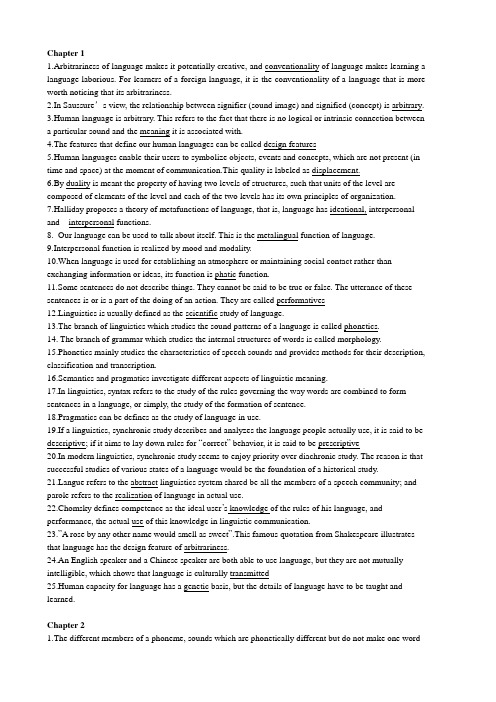
Chapter 11.Arbitrariness of language makes it potentially creative, and conventionality of language makes learning a language laborious. For learners of a foreign language, it is the conventionality of a language that is more worth noticing that its arbitrariness.2.In Saussure’s view, the relationship between signifier (sound image) and signified (concept) is arbitrary.3.Human language is arbitrary. This refers to the fact that there is no logical or intrinsic connection betweena particular sound and the meaning it is associated with.4.The features that define our human languages can be called design features5.Human languages enable their users to symbolize objects, events and concepts, which are not present (in time and space) at the moment of communication.This quality is labeled as displacement.6.By duality is meant the property of having two levels of structures, such that units of the level are composed of elements of the level and each of the two levels has its own principles of organization.7.Halliday proposes a theory of metafunctions of language, that is, language has ideational, interpersonal and interpersonal functions.8. Our language can be used to talk about itself. This is the metalingual function of language.9.Interpersonal function is realized by mood and modality.10.When language is used for establishing an atmosphere or maintaining social contact rather than exchanging information or ideas, its function is phatic function.11.Some sentences do not describe things. They cannot be said to be true or false. The utterance of these sentences is or is a part of the doing of an action. They are called performatives12.Linguistics is usually defined as the scientific study of language.13.The branch of linguistics which studies the sound patterns of a language is called phonetics.14. The branch of grammar which studies the internal structures of words is called morphology.15.Phonetics mainly studies the characteristics of speech sounds and provides methods for their description, classification and transcription.16.Semantics and pragmatics investigate different aspects of linguistic meaning.17.In linguistics, syntax refers to the study of the rules governing the way words are combined to form sentences in a language, or simply, the study of the formation of sentence.18.Pragmatics can be defines as the study of language in use.19.If a linguistics, synchronic study describes and analyzes the language people actually use, it is said to be descriptive; if it aims to lay down rules for “correct” behavior, it is said to be prescriptive20.In modern linguistics, synchronic study seems to enjoy priority over diachronic study. The reason is that successful studies of various states of a language would be the foundation of a historical study.ngue refers to the abstract linguistics system shared be all the members of a speech community; and parole refers to the realization of language in actual use.22.Chomsky defines competence as the ideal user’s knowledge of the rules of his language, and performance, the actual use of this knowledge in linguistic communication.23.”A rose by any other name would smell as sweet”.This famous quotation from Shakespeare illustrates that language has the design feature of arbitrariness.24.An English speaker and a Chinese speaker are both able to use language, but they are not mutually intelligible, which shows that language is culturally transmitted25.Human capacity for language has a genetic basis, but the details of language have to be taught and learned.Chapter 21.The different members of a phoneme, sounds which are phonetically different but do not make one worddifferent from another in meaning, are allophones.2. The three cavities in the articulatory apparatus are the pharynx, mouth, and nose. six places of articulation according to Fromkin and Rodman throat,palate,palate top,teeth,lips,nose,4. Name five of English front vowels: i:, i, e, æ, a.5.The sound [p] can be described with “ voiceless, bilabial, stop”6.In the production of a velar sound, the back of the tongue is raised so that it touches the soft palate to form a kind of obstruction.7. By the position of the highest part of the tongue, vowels are classified as front vowels, central vowels and back vowels.8.Pitch,as a principal suprasegmental features, can be defined as the relative intensity of soundness with which a syllable is uttered.9.In English, the sound [b] has the same phonetic features as the sound [p] except the feature of voicing.10. Assimilation refers to the change of a sound as a result of the influence of an adjacent sound.11. The oral stops in English are b, p, d, t, g and k.12.When pitch, stress and length variation are tied to the sentence rather than to the word, they are collectively known as intonation.1.The sound [p] can be described with " voiceless, bilabial, stop".2.The sound [b] can be described with " voiced, bilabial, stop"3.Consonant articulations are relatively easy to feel, and as a result are most conveniently described in terms of place and manner of articulation.4.Consonants are produced by constricting or obstructing the vocal tract at some place to divert, impede, or completely shut off the flow of air in the oral cavity.5.The present system of the cardinal vowels derives mainly from one developed in the 1920s by the British phonetician, Daniel Jones (1881-1967), and his colleagues at University of London.6.Consonant articulations are relatively easy to feel, and as a result are most conveniently described in terms of place and manner of articulation.7.The sound /k/ can be described with “voiceless,velar,stop”.8.Narrow transcription should transcribe all the possible speech sounds, including the minute shades.9.Assimilation refers to the change of a sound as a result of the influence of an adjacent sounds.10.Stress refers to the degree of force used in producing a syllable.11.The syllable structure in Chinese is CVC or CV or V.12.The different members of a phoneme, sounds which are phonetically different but do not make one word different from another in meaning, are allophone of airstream.13.In English, the two words cut and gut differ only in their initial sounds and the two sounds are two different phonemes and the 2 words are a minimal pair.14.Consonants differ from vowels in that the latter are produced without obstruction of airstream.15.In English there are a number of diphthong,.which are produced by moving from one vowel position to another through intervening positions.16.According to the maximal onset principle, when there is a choice as to where to place a consonant, it is put into the onset rather than the coda17.In phonological analysis the words fail-veil are distinguishable simply because of the two phonemes /f/ -/v/.This is an example for illustrating minimal pairs.Chapter 31.Polymorphemic words other than compounds have two parts: the roots and the affixes2. On, before and together are grammatical words ---- they are words which do not take inflectional endings.3. Give the regular allomorphs of plural in English: /n/, /i:/, /s/, /z/, /iz/.4. Give the regular allomorphs of past tense in English: /iə/, /t/, /d/.5. Nouns, verbs and adjectives are context words other than function words.6. In the addition of new words, smog is a(an) blending.7.Waltz is borrowed from German.8. As a result of assimilation, the negative morpheme in imperfect and impossible is “im-”rather than “in-”.9. The linguistic term used for the common factor of a set of verbs, such as writing, wrote, written, write and writes is lexeme.10. A bound morpheme is one that cannot constitute a word by itself.1.As the lexical words carry the main content of a language while the grammatical ones serve to link its different parts together, the lexical words are also known as content words and grammatical ones affixes.2.In traditional grammar, pronoun is the only word class which can function as a substitute for another item.3.In terms of the meaning expressed by words, they can be classified into Grammatical words and lexical words.4.The morpheme is the minimal distinctive unit in grammar, a unit which cannot be divided without destroying or drastically altering the meaning, whether lexical or grammatical.5.There are 2 fields of morphology: the study of inflectional morphology and the study of derivational morphology.6.A bound morpheme is one that cannot stand by itself7.Morphology is a branch of linguistics that studies that studies the interrelationship between phonology and morphology.8.Blending is a relatively complex form of compounding in which a new word is formed by joining the initial part of one word and the final part of another word. For example, the English word smog is made from smoke and fog.9.Back-formation”refers to an abnormal type of word-formation where a shorter word is derived by detecting an imagined affix from a longer form already in the language.10.Word is a unit of expression that has universal intuitive recognition by native speakers, whether it is expressed in spoken or written form. It is the minimum free form.11.Affix is the collective term for the type of formative that call be used only when added to another morpheme. Affixes are limited in number in a language, and are generally classified into three subtypes, namely, prefix, suffix, and infix.12.Take is the lexeme of taking, taken and took.13.Bound morphemes are classified into 2 types: affix and bound root,.14.A word formed by derivation is called a derivative, and a word formed by compounding is called a compound.Chapter 41.IC is the short form of immediate constituent used in the study of syntax.2.Coordination and subordination belong to endocentric construction.4.A coordinate sentence contains two clauses joined by a linking word, such as "and", "but", "or".5.A clause that takes a subject and a finite verb, and at the same time stands structurally alone is known as a finite clause.6.IC analysis emphasizes the hierarchical structure of a sentence, seeing it as consisting of word groups7.Syntactic movement is dictated by rules traditionally called transformational rules, whose operation may change the syntactic representation of a sentence.8.Syntactic relations include positional relation, relation of substitutability,relation of co-occurrence. three of SVO languages:English, Chinese, French2.IC is the short from of immediate constituent used in the study of syntax.3.The category of case is prominent in the grammar of Latin, with six distinctions of nominative vocative, accusative, genitive, dative and ablative.4.The generative approach to linguistics refers to the theory originated with the American linguist Norm Chomsky, who published his book Syntactic Structures in 1957.5.When the affirmative sentence “Jack sold his linguistics textbooks to Jill after the final examination” is transformed into “When did Jack sell his linguistics textbooks to Jill?”,three transformational rules are applied. They are Do -insertion, Subject-aux Inversion and Wh-movement.6.The sentence “It was John who wore his best suit to the dance last night.” is called a cleft sentence by traditional grammarians.7.Exocentric construction usually includes basic sentence, prepositional phrase, predicate (verb+object) construction, and connective(be complement)construction.8.According to Chomsky, grammar is a mechanism that should be able to generate all and only the grammatical sentences of a language.Chapter 51.Human language is arbitrary. This refers to the fact that there is no logical or intrinsic connection betweena particular sound and the meaning it is associated with.2.Predication analysis is to break down predications into their constituents:argument and predicate3.The sense relation between “A lent a book to B” and “B borrowed a book from A” is synonymy4.Antonyms like ”husband” vs. ”wife” are converse antonyms.5. Terms like ”desk” and ”stool” are hyponyms of the term “furniture”.6.According to D. Leech, conceptual meaning refers to logic, cognitive, or denotative content.7.We use the term presupposition to refer to the relation between the following two sentences:A. Jack‟s bike needs repairing.B. Jack has a bike.8.The idea that the meaning of a sentence depends on the meanings of the constituent words and the way they are combined the principle of compositionality.9. Inspired by the medieval grammarians, Ogden and Richard (1923) present the classic“semantic triangle” in their book The Meaning of Meaning.Chapter 61.Psycholinguistics is the study of language in relation to the mind.2.According to Chomsky, competence is the ideal user’s knowledge of the rules of his language.3.The most important part of the brain is the outside surface of the brain,called the cerebral cortex4.The brain is divided into two roughly symmetrical halves, called hemispheres, one on the right and one on the left.5.Brain arterialization is genetically programmed, but takes time to develop,6.In general, the two-word stage begins roughly in the second half of the child’s second year.7.The relationship between the name and the meaning of a word is quite arbitrary.8.When language and thought are identical or closely parallel to each other, we may regard thought assub-vocal speech as overt thought.9.Because language differs in many ways, Whorf believed that speakers of different languages perceive and experience the world differently, relative to their linguistic background. This notion is called linguistic relativity.10.Psycholinguists consider that the first language is acquired in the short period from about age two to puberty, which is called the critical period of the first language acquisition.11. The strong version of the Sapir-Whorf hypothesis has two aspects: linguistic determinism and linguistic reality.12. The cohort model is a supposed doctrine dealing with the spoken word recognition, whose process features that the first few phonemes of a spoken word activate a set or cohort of word candidates that are consistent with the input.13.Metaphor involves the comparison of two concepts in that one is construed in terms of the other. It’s often described in terms of a target domain and a source domain.14.Children frequently say tooths and mouses, instead of teeth and mice. These are examples of overgeneralization16.Psycholinguistics is concerned primarily with investigating the psychological reality of linguistic structures.17.According to critical period hypothesis, in child development there is a period during which language can be acquired more easily than at any other time. The period lasts until puberty (around 12or 13 years), and is due to biological development.Chapter 71.Idiolect refers to varieties of a language used by individual speakers, with peculiarities of pronunciation, grammar and vocabulary. In fact, no two speakers speak exactly the same dialect. Each speaker has certain characteristic features of his own in his way of speaking.2.We witnessed a change in language teaching in the middle of the 1970s when Hymes’ theory of communicative competence was introduced into the field as an antagonism to the traditional philosophy in language teaching.3.The social group isolated for study is any given study is called the speech community.4.Speech variety refers to any distinguishable from of speech used by speaker or group of speakers.5.From the sociolinguistic perspective,a speech variety is no more than a dialectual variety of a language.nguage standardization is also called language planning.7.Social variation gives rise to sociolects which are subdivisible into smaller speech categories that reflect their socioeconomic, educational, occupational background,etc.8.Stylistic variation in a person’s speech or writing usually ranges on a continuum from casual or colloquial to formal or polite according to the type of communicative situation.9.A reginal dialect may gain status and become standardized as the national or official language of a country.10.Variety is a neutral term, and it can be used instead of regional or official dialect, or pidgin.11.Sociolinguistics is a multidisciplinary research field focusing on the relationship between language and society.12.The differences between men and women’s language can be traced to many biological, psychological and social reasons.13.The goal of sociolinguistics is to explore the nature of language variation and language use among a variety of speech communities and in different social situation.14.Every speaker of a language is, in a stricter sense, a speaker of a distinct idiolect.15.A pidgin usually reflects the influence of the higher, or dominant, language in its lexicon and that of the lower language in their phonology and occasionally syntax.16.Social variation gives rise to sociolects which are subdivisible into smaller speech categories that reflect their socioeconomic, educational, occupational background.第1章语言1.Arbitrariness使得它有可能创造和语言的规约,使学习吃力的语言。
语言学概论试题及参考答案
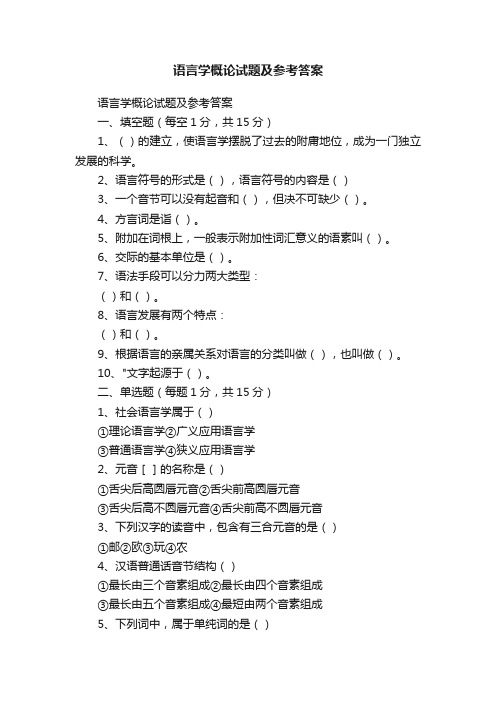
语言学概论试题及参考答案语言学概论试题及参考答案一、填空题(每空1分,共15分)1、()的建立,使语言学摆脱了过去的附庸地位,成为一门独立发展的科学。
2、语言符号的形式是(),语言符号的内容是()3、一个音节可以没有起音和(),但决不可缺少()。
4、方言词是诣()。
5、附加在词根上,一般表示附加性词汇意义的语素叫()。
6、交际的基本单位是()。
7、语法手段可以分力两大类型:()和()。
8、语言发展有两个特点:()和()。
9、根据语言的亲属关系对语言的分类叫做(),也叫做()。
10、"文字起源于()。
二、单选题(每题1分,共15分)1、社会语言学属于()①理论语言学②广义应用语言学③普通语言学④狭义应用语言学2、元音[]的名称是()①舌尖后高圆唇元音②舌尖前高圆唇元音③舌尖后高不圆唇元音④舌尖前高不圆唇元音3、下列汉字的读音中,包含有三合元音的是()①邮②欧③玩④农4、汉语普通话音节结构()①最长由三个音素组成②最长由四个音素组成③最长由五个音素组成④最短由两个音素组成5、下列词中,属于单纯词的是()①玻璃②黑扳③语言④红旗6、下列词中,属于复台词的是()①傻子②席子③天子④椅子7、下列词组中,属于多义的是()①两只学生送的花瓶②两位学生送的花瓶③两只学生送的花篮。
④两个学生送的花篮8、下列词中粗体的成分,属于同音关系的是()①杜鲁门——杜绝②负荆一负担③忽然--突然④花朵——浪花9、英语的‘foot”(脚,单数)变为“feet”(脚,复数)运用的语法手段是()①附加②异根③内部屈折④重叠10、"汉语普通话中的:“卡通片”中的“卡”是一个()①语素②音节③前缀④词11、"汉语中的:“了、着、过”在古代具有实实在在的词汇意义,到现代变成只1表语义的助词,这属于()①异化②类化③新语法范畴的形成④实词虚化12、"下列语言中属于粘着语的是()①苗语②越南语③俄语④日语13、"在一种语言内部划脑言时,最主要的依据是()①语法②语义③语音④词汇14、"下列词的词义,属于词义缩小的是()①“皮”原指兽皮②“涕”原指眼泪③“瓦”原指一切烧好的上器④“江”原捐“长江”15、"人类几种古老文字的原始字形,都是()①象形的②会意的③表音的④形声的三、多选题(在本题的每一小题的备选答案中,正确答案有三个或三个以上。
语言学
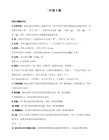
2、国际音标中有些符号由两个字母组成。( 对 )
3、不同的元音音素是因为舌位的高低形成的。( 错 )
4、声母和韵母是音素的两个类别。( 对 )
5、元音[i]和[u]的区别主要是舌位前后不同。( 错 )
6、[a]、[A]、[?]是汉语普通话中同一音位的三个自由变体。( 对 )
10、汉语音节可分( 声母、韵母、声调 )三部分,其中( 韵母 )又可分( 韵头 )、韵腹和( 韵尾 )。
11、“四呼”是指( 开口呼、合口呼、齐齿呼、撮口呼 )。
12、人们在说话时,常常把[toufu](豆腐)说成[touf],这种音变现象叫做( 脱落 )。
三、辨别正误(10分,每小题1分)
4、人类发音器官分( 动力器官 )、(共鸣腔 )、(发音体 )三大部分,(共鸣腔 )部分主要作用是调节气流,许多不同的音素,就是这一部分的变化形成的。
5、音素可分( 元音 )和( 辅音 )两大类,其区别的根本点是发音时气流在口腔中是否( 受阻 )。
6、元音的音质是由(舌位高低 )、(舌位前后)、(嘴唇圆展 )三个方面决定的,例如[A]是( 舌面中、不圆唇、低)
一、填空(20分,每空0.5分)
1、( 音素)是从自然属性角度划分出来的最小的语音单位。
2、国际音标是以( 拉丁 )字母为基础构成的,通常把它放在方括号中,与一般字母区别开来。
3、从物理属性角度看,语音具有( 音高 )、( 音重 )、( 音长 )、( 音质 )四个要素,汉语的声调,就是由于(音高 )的变化形成的。
传统语文学Leabharlann 括文字学、训诂学、音韵学 语言学派的代表人物,代表作,历史地位(标志着),索绪尔
语言学第一章习题(含答案)

第一章语言的功能一、填空题.从语言的社会功能上看,语言是人类独有的最重要的交际工具和思维工具:从语言的内部结构上看,语言是一套音义结合的符号系统。
1 .文字是建立在语言基础上的最重要的辅助交际工具:旗语之类是建立在语言和」^基础上的特殊领域的辅助交际工具。
2 . 一种语言的句子数量是无限的,但无限的句子中却包含着有限的博鼠和为数不多的规则。
3 .人类的交际工具分的交际工具和身势等非语言的交际工具。
4 .语言是一种特殊的社会现象的含义是,语言具有全人类性,没有阶级性。
5 .思维的类型可分为宜.观动作思维、表象思维、抽象思维。
抽象思维的三种形式是概念、判断、推理。
6 .人和动物的区别是人会制造工具,而且人类有语言,这是人和动物相区别的重要标志之一。
7 .在一定条件下,身体姿势等伴随动作还可以离开语言独立完成交际任务,例如汉民族点头袤示同意,摇头表示不同意,咬牙切齿表示愤怒,手舞足蹈京示激动或高兴°.人的大脑分左右两半球,大脑的上半球控制语言活动,右半球掌管不需要语言的感性思维。
8 .汉语的哥哥、弟弟,英语用brother表示:汉语的舅妈、姑妈、姨妈、婶婶,英语用aunl 表示。
9 .英语可以直接用数词修饰名词,汉语数词修饰名词一般要加上一个.儿童最早的智力活动就是学习^10 .如果一个病人大脑&半球发生损伤,他尽管说不出他家的地址,却认得自己的家门。
相反,大脑)半球发生损伤,他尽管能说出他家的地址,却找不到自己的家门。
二、判断题.从理论上来说,句子的长度是可以无限的。
(1 .语言是在文字基础之上产生的人类最重要的交际工具。
(X).文字始终是从属于语言的。
(X)2 .在一定的条件下,身势等伴随动作也可以脱离语言而独立完成一些交际任务。
(J).现代社会沟通的方式很多,语言的重要性正日渐削弱。
(X)3 .语言是组成社会的一个不可缺少的因素。
(J).我们常听人们说“工人有工人的语言,农民有农民的语言”,这说明语言是有阶级性的。
语言学概论填空题
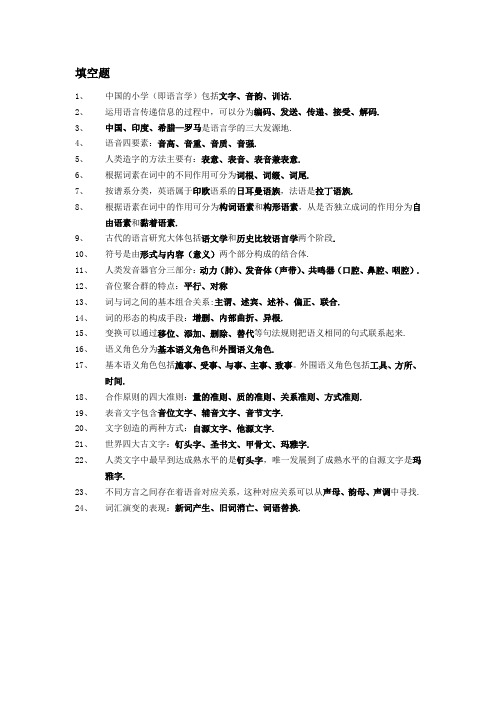
填空题1、中国的小学(即语言学)包括文字、音韵、训诂.2、运用语言传递信息的过程中,可以分为编码、发送、传递、接受、解码.3、中国、印度、希腊—罗马是语言学的三大发源地.4、语音四要素:音高、音重、音质、音强.5、人类造字的方法主要有:表意、表音、表音兼表意.6、根据词素在词中的不同作用可分为词根、词缀、词尾.7、按谱系分类,英语属于印欧语系的日耳曼语族,法语是拉丁语族.8、根据语素在词中的作用可分为构词语素和构形语素,从是否独立成词的作用分为自由语素和黏着语素.9、古代的语言研究大体包括语文学和历史比较语言学两个阶段.10、符号是由形式与内容(意义)两个部分构成的结合体.11、人类发音器官分三部分:动力(肺)、发音体(声带)、共鸣器(口腔、鼻腔、咽腔).12、音位聚合群的特点:平行、对称13、词与词之间的基本组合关系:主谓、述宾、述补、偏正、联合.14、词的形态的构成手段:增删、内部曲折、异根.15、变换可以通过移位、添加、删除、替代等句法规则把语义相同的句式联系起来.16、语义角色分为基本语义角色和外围语义角色.17、基本语义角色包括施事、受事、与事、主事、致事。
外围语义角色包括工具、方所、时间.18、合作原则的四大准则:量的准则、质的准则、关系准则、方式准则.19、表音文字包含音位文字、辅音文字、音节文字.20、文字创造的两种方式:自源文字、他源文字.21、世界四大古文字:钉头字、圣书文、甲骨文、玛雅字.22、人类文字中最早到达成熟水平的是钉头字,唯一发展到了成熟水平的自源文字是玛雅字.23、不同方言之间存在着语音对应关系,这种对应关系可以从声母、韵母、声调中寻找.24、词汇演变的表现:新词产生、旧词消亡、词语替换.。
语言学填空题

1、Language has many functions. We can use language to talk aboutitself. This function is called __________________.2、The description of a language as it changes through time is____________________. The analysis of a language at any given point in time is _______________________.3、Linguistic potential(语言潜能) is similar to Saussure’slanguage(语言) and Chomsky’s ___________. The knowledge involved in competence is generally unconscious. A transformational-generative grammar is a model of competence. 4、____________ refers to the actual realization of the ideal languageuser’s knowledge of the rules of his language in utterances.5、The interdisciplinary(交叉学科的) studies of language are alsocalled _______________________. They are sociolinguistics, anthropological linguistics, neurological linguistics, mathematical linguistics and computational linguistics.6、It is genetic evidence which tells us that we are separated by onlyabout _________________ years from the ancestor which we share the chimpanzees.7、Theory that primitive man made involuntary vocal noises whileperforming heavy work has been called __________ theory.8、The history of the English language begins with the conquest andsettlement of what is now England by the ________,________,________.9、The ancient learned language of India is called _________.10、What separated the period of Middle English from that ModernEnglish was European ___________ movement.11、As far as language is concerned, arbitrary means there is no logicalconnection between meaning and ______________.12、As far as organs of speech are concerned, the first place wheresound modification might occur is _________.13、One main area of phonetics is called _________ phonetics, whichinvestigates the properties of the sound waves.14、One of the oldest notions concerning the study of meaning is thenaming theory proposed by the ancient Greek scholar__________.15、The linguistic context, also known as ________, is concerned withthe probability of a word’s co-occurrence or collocation with another word, and also with the part of text that precedes and follows a particular utterance.16、When two words are identical in sound, they are __________.When two words are identical in spelling, they are __________. 17、The words “bed”, “table”, “desk”, etc, are the hyponyms of thesame superordinate “furniture”. They are called __________ to each other.18、Componential analysis is an approach based upon the belief thatthe meaning of a word can be dissected into meaning components, called semantic ____________.19、According to Noam Chomsky, syntactic rules comprise the systemof internalized linguistic knowledge of a language speaker known as linguistic _____________.20、 A coordinate sentence contains two clauses joined by a linkingword called coordinating ____________ such as and, but, or.21、 A linguistic _________ refers to a word or expression that isprohibited by the “polite” society from general use.22、In terms of sociolinguistics, __________ is sometimes used to referto the whole of a person’s language.23、___________ arise when children acquire pidgins natively.24、___________ are used as second language in situations of regularcontact between people with mutually unintelligible mother tongues.25、Language _________ means the government of a country choosesa particular speech variety and spread the use of it, including itspronunciation and spelling system.26、 A child acquires his/her mother tongue invariably through thesephases: _________, one-word, two-word and multiword.27、At the age of _____, children can master the essential of theirmother tongue.28、It is generally believed that three areas of the left hemisphere arevital to language, namely, Broca’s area, Wernicke’s area and _________ gyrus.29、The critical period hypothesis refers to a period in one’s lifeextending from age two to __________, during which the human brain is most ready to acquire a particular language and language learning can proceed easily, swiftly, and without explicit instruction.30、In the dozen years between 1921 and 1933, the three best knownEnglish-speaking linguistic in the world (Edward Sapir in 1921, Otto Jespersen in 1922, and Leonard Bloomfield in 1933) all wrote books under the title ________.31、The fact that three are now many language rather than just one isexplained in the story of ______________________ linguistic diversity is a punishment for human arrogance.32、The American psychologist ___________, the founder ofBehaviorism, stated that language and thought was the same thing.33、The morphemes that cannot be used by themselves, but must becombined with other morphemes to form words are called b_____ morphemes.34、V owels can be nasalized. The vowel nasalization rule is ana_________ rule, which, for the most part, is caused by articulatoryor physiological process in which successive sounds are made identical, or more similar, to one another.35、Pairs of words such as “big” and “small” , “ young” and “old” arecalled g_________ opposites because they may be seen in terms of degree of the quality involved.36、In producing the English vowels, the air stream coming up fromthe lungs meets with no o__________ in whatsoever manner. 37、The terms such as “desk”, “chair” and “bed” are ___________ ofthe term “furniture”.38、In English, the two words cut and gut differ only in their initialsounds and the two sounds are two different ________ and the two words are a ________ pair.39、The branch of grammar which studies the internal structure ofsentences is called ________.40、When language is used for establishing an atmosphere ormaintaining social contact rather than exchanging information or ideas, its function is _________ function.41、。
语言学试题及答案

语言学试题及答案一、选择题1. 语言学是一门研究语言的科学,它主要关注语言的哪些方面?A. 语音和语法B. 词汇和语义C. 语音、语法、词汇和语义D. 语法和语用答案:C2. 下列哪个选项不属于语言学的分支学科?A. 语音学B. 语法学C. 心理学D. 语用学答案:C3. 语言的最小意义单位是什么?A. 音素B. 词C. 语素D. 句子答案:C二、填空题4. 语言学中的“_______”是指语言的物理表现形式。
答案:语音5. 语言学中的“_______”是指语言的抽象系统,包括语法规则和词汇。
答案:语法6. 语言学中的“_______”是指语言的最小意义单位。
答案:语素三、简答题7. 简述语言学的主要研究方法。
答案:语言学的主要研究方法包括观察法、实验法、调查法、统计法等。
观察法是通过观察语言现象来收集数据;实验法是在控制条件下进行语言实验以验证假设;调查法是通过问卷、访谈等方式收集语言使用情况;统计法是利用统计学原理分析语言数据。
8. 描述语言学和历史语言学的区别。
答案:描述语言学关注的是特定语言在某一特定时间点的状态,它试图描述和解释语言的结构和功能;而历史语言学关注的是语言随时间的变化和发展,研究语言的起源、演变以及不同语言之间的亲缘关系。
四、论述题9. 论述语言与文化之间的关系。
答案:语言与文化之间存在着密切的关系。
首先,语言是文化的载体,通过语言可以传递和保存文化信息。
其次,语言反映了文化的特点,不同文化背景下的语言会有不同的表达方式和词汇。
此外,语言的使用也受到文化规范和价值观的影响,例如礼貌用语、禁忌语等。
最后,语言的发展和变化也受到文化因素的影响,文化变迁往往伴随着语言的演变。
10. 分析语言的多样性对全球化的影响。
答案:语言的多样性对全球化有着复杂的影响。
一方面,语言多样性丰富了人类的文化生活,促进了不同文化之间的交流与理解。
另一方面,语言多样性也带来了沟通上的障碍,全球化进程中需要跨越语言障碍以实现信息的自由流通。
语言学概论题库

语言学概论题库一、填空题1.理论语言学以研究对象的不同,又可分为()和()。
2.人类对语言的研究大体上可分为()阶段、()阶段、()阶段、()阶段、()阶段。
3.语言学概论课是()的入门课。
4.()、()、()具有悠久的历史文化传统,是语言学的三大发源地。
5.中国传统的“小学”是指()、()、()。
6.()是我国古代的书面语,用它写成的文章称为()。
7.()被称为现代语言学之父,其代表作(《普通语言学教程》)在语言学史上具有十分重要的地位。
8.以某一种具体语言为研究对象的语言学叫()。
9.()的建立,使语言学摆脱了过去的附庸地位,成为一门独立发展的科学。
10.从一个横断面描写研究语言在一个时期的状态的语言学就是()。
11.语言学的主要任务是研究语言的()和()。
12.语言研究有悠久的历史,是一门古老的学科,人们一般称之为()。
该时期的语言研究是以()为主要研究对象的。
13.运用语言传递信息的过程,可以分为()、()、()、()、解码五个阶段。
14.历史比较语言学的先驱人物是();草创者是();奠基人物是拉斯克、葆朴、格林。
15.()不但宣告语言学的真正独立、而且为普通语言学的研究奠定了基础。
16.普通语言学的奠基人物是()和()。
(《》)在语言学发展史上起到了划时代的作用。
17.结构主义语言学派可以分为三派,它们是(布拉格学派)、(哥本哈根学派)、(美国学派)。
18.形式语言学的主要代表人物是(),他认为对语言进行描写和分析的目的在于研究人的()能力。
他的目标是建立一个能产生所有句子的()。
19.新时期语言学的最大特点是()、()。
20.人和动物的区别是人会制造生产工具进行劳动,而且人来有(),这是人和动物相区别的重要标志之一。
21.一种语言中句子数量是无限的,人类之所以能掌握语言,是因为构成句子的语言材料和()是十分有限的。
22.语言是人类社会的(),而且也是思维的(),这是语言的两大功能。
23.人的大脑分左右两半球,大脑的()半球控制语言活动,右半球掌管不需要语言的感性直观思维。
- 1、下载文档前请自行甄别文档内容的完整性,平台不提供额外的编辑、内容补充、找答案等附加服务。
- 2、"仅部分预览"的文档,不可在线预览部分如存在完整性等问题,可反馈申请退款(可完整预览的文档不适用该条件!)。
- 3、如文档侵犯您的权益,请联系客服反馈,我们会尽快为您处理(人工客服工作时间:9:00-18:30)。
nguage, broadly speaking, is a means of __________ communication.2.In any language words can be used in new ways to mean new things and can be combined into innumerable sentences based on limited rules. This feature is usually termed __________.3. Language has many functions. We can use language to talk about itself. This function is __________.4.Theory that primitive man made involuntary vocal noises while performing heavy work has been called the __________ theory.5.Linguistics is the __________ study of language.6.Modern linguistics is __________ in the sense that the linguist tries to discover what language is rather than lay down some rules for people to observe.7.One general principle of linguistic analysis is the primacy of __________ over writing.8.The description of a language as it changes through time is a __________ study.9.Saussure put forward two important concepts. __________ refers to the abstract linguistic system shared by all members of a speech community.10.Linguistic potentia l is similar to Saussure’s langue and Chomsky’s __________.1,verbal 2.productivity / creativity 3.metalingual function 4.yo-he-ho5.scientific6.descriptive7.speech8.diachronic linguistic9. langue petence11.Consonant sounds can be either __________ or __________, while all vowel sounds are _________12.Consonant sounds can also be made when two organs of speech in the mouth are brought close together so that the air is pushed out between them, causing __________.13. The qualities of vowels depend upon the position of the __________ and the lips.14. One element in the description of vowels is the part of the tongue which is at the highest point in the mouth. A second element is the __________ to which that part of the tongue is raised.15. Consonants differ from vowels in that the latter are produced without __________.16. In phonological analysis the words fail / veil are distinguishable simply because of the two phonemes /f/ - /v/. This is an example for illustrating __________.17. In English there are a number of __________, which are produced by moving from one vowel position to another through intervening positions.18. __________ refers to the phenomenon of sounds continually show the influence of their neighbors.19. __________ is the smallest linguistic unit.20. Speech takes place when the organs of speech move to produce patterns of sound. These movements have an effect on the __________ coming from the lungs.11. voiced, voiceless, voiced 12. friction 13. tongue 14. Height 15. obstruction16. minimal pairs 17. Diphthongs 18. Co-articulation 19. Phonemes 20. air stream21.An __________ is pronounced letter by letter, while an __________ is pronounced as a word.22. Lexicon, in most cases, is synonymous with __________.23.Orthographically, compounds are written in three ways: __________, __________ and __________.24.All words may be said to contain a root __________.25. A small set of conjunctions, prepositions and pronouns belong to __________ class, while the largest part of nouns, verbs, adjectives and adverbs belongs to __________ class.26. __________ is a reverse process of derivation, and therefore is a process of shortening.27.__________ is extremely productive, because English had lost most of its inflectional endings by the end of Middle English period, which facilitated the use of words interchangeably as verbs or nouns, verbs or adjectives, and vice versa.28. Words are divided into simple, compound and derived words on the __________ level.29. A word formed by derivation is called a __________, and a word formed by compounding is called a __________.30. Bound morphemes are classified into two types: __________ and __________21. initialism, acronym 22. V ocabulary 23. solid, hyphenated, open 24. morpheme 25. close, open 26. back-formation 27. conversion 28. morpheme29. derivative, compound 30. affix, bound root21.__________ can be defined as the study of meaning.22. The conceptualist view holds that there is no __________ link between a linguistic form and what it refers to.23. __________ means what a linguistic form refers to in the real, physical world; it deals with the relationship between the linguistic element and the non-linguistic world of experience.24. Words that are close in meaning are called __________.25. When two words are identical in sound, but different in spelling and meaning, they are called __________.26. __________ opposites are pairs of words that exhibit the reversal of a relationship between the two items.27. __________ analysis is based upon the belief that the meaning of a word can be divided into meaning components.28. Whether a sentence is semantically meaningful is governed by rules called __________ restrictions, which are constraints on what lexical items can go with what others.29. A(n) __________ is a logical participant in a predication, largely identical with the nominal element(s) in a sentence.30. According to the __________ theory of meaning, the words in a lan¬guage are taken to be labels of the objects they stand for.21.Semantics 22. Direct 23. Reference 24. Synonyms 25. homophones26.Relational27. Componential 28. Selectional 29. argument 30. Naming21.Chomsky defines “competence” as the ideal user’s __________ of the rules of his language.22. Langue refers to the a__________ linguistic system shared by all the members of a speech co mmunity while the parole is the concrete use of the conventions and application of the rules. 23. D_________ is one of the design features of human language which refers to the phenomenon that language consists of two levels: a lower level of meaningless individual sounds and a higher l evel of meaningful units.24. Language is a system of a_________ vocal symbols used for human communication.25. The discipline that studies the rules governing the formation of words into permissible sentenc es in languages is called s________.26. Human capacity for language has a g_______ basis, but the details of language have to be taug ht and learned.27. P _______ refers to the realization of langue in actual use.28. Findings in linguistic studies can often be applied to the settlement of some practical problems . The study of such applications is generally known as a________ linguistics.29. Language is p___________ in that it makes possible the construction and interpretation of new signals by its users. In other words, they can produce and understand an infinitely large number of sentences which they have never heard before.30. Linguistics is generally defined as the s _______ study of language.21. knowledge 22. abstract 23. Duality 24. arbitrary 25. syntax26. genetic 27. Parole 28. applied 29. productive 30. scientific (or systematic)Chapter one1.Linguistics is generally defined as the .2.The study of language as a whole is often called .3.The study of_ used in linguistic communication led to the establishment of phonetics.4.The study of is known as semantics.5.Psycholinguistics relates the study of language to .6. The study of is generally known as applied linguistics.7. If a linguistic study aims to describe and analyze the language people actually use, it is said to be .8. The description of a language at some point of time in is a synchronic study the description of a language as it through time is a diachronic.9. From the point of view of linguistic evolution, speech is to writing.10. _ refers to the abstract linguistic system shared by all the member of a speech community, and refers to the realization of langue in actual use.11. Linguistic is descriptive while traditional grammer is .12. Modern linguistic regards the language as primary, not the written.13. Many of the rules of traditional grammer apply only to the language.14. When the study of meaning is ,not in isdation ,but in the context of language use, itbecomes another branch of linguistic study called pragmatics.15. Prescriptive and descriptive represent two different of linguistic study.答案:1.scientific study of language2.general linguistics3.sounds4.meaning5.psychology6.applications7.descriptive8.history; changes9.priorngue; parole11.prescriptive12.spoken13.written14.conducted15.typesChapter Two1. Phonetics is defined as the study of the of language; if is concerned with all the sounds that occur in the world’s language.2. The three branches of phonetics are_ , auditory phonetics and acousfic phonetics respectively.3. English consonants can be classified in two ways: one is in terms of _and the other is in terms of _ .4. Both phonology and phonetics are concerned with the same aspect of language-_______.5. The different throes which can represent a phoneme in different phonetics envronments are called the _ of that phoneme.6. The assimulation rules assimilates one sound to another by “copying” a feature of a_______;thus making the two phones similate.7. The assimulation rule also accounts for the _______ of the alvedar nasal in some sound combinations.8. The deletion rule tells us when a sound is to be deleted although it is______.9. Language is first ______through its sounds.10. The letter [P] in terms of place of articulation______ in terms of manner of articulation is _______.11. _______, not phonetic identity is the ctciterion with which we operate the phonological analysis of language .12. The greatest source of modification of the air stream is founding the _______.13. Corresponding to the distinction of long and short vowels is the distinction of _____and______ vowels .14. A phoneme is further analyzable because it consists of a set of______.15. Similar alteration of stress also occurs between a ______and a phrase consisting of the same elements.答案:1.phonic mediumbeled articulation phonetics3.manner of articulation; place of articulation4.the speech sounds5.allo phones6.sequential phoneme7.varying pronunciation8.orthographically represented9.perceived10.bilabial; stops11.phonetic similarity12.oral cavity13.tense; lox14.simultaneous distinctive featurespound nounChapter Three1.Linguists define the word as the smallest ______found in language.2.Morpheme is the_______________ that carries information about meaning or function.3.The root consistutes the _____ of the word and carries the major components of itsmeaning .4.Morpheme are usually ______: there is no nature connection between their sound andmeaning.5.When _______ are conjoined to other morpheme (or words), a new words are derived , orformed.6.Derivation is an _______ that form a word with meaning and category distinct from that ofits bases.7.Unlike phonemes and syllables which are the elements of sound , words_______.8.______ are the foundation building blocks of a language .9.Linguists use the term morphology to refer to the part of the grammer that is concerned with______ and ________.10.The content words of language , such as ____,_____,_____and adverbs, are sometimes calledopen class words.11.Affixes______ belong to a lexical category and are always bound morpheme.12.Bound morphemes which are for the most part purely grammatical makers and signify suchconcepts as tense, number, case are called_________.13._______, ________ and free morphemes combine are the major ways to produce new words.14.The ways word are formed are called _______.15.When two words are in the same _______, the compound will be in this category.答案:1.free form2.smallest unit of language3.core4.arbitrary5.derivational morphemes6.affixational process7.carry meaning8.words9.word formation; word structure10.nouns; verbs; adjectives11.do not12.inflectional morphemes13.derivation; compounds14.morphological rules15.grammatical categoryChapter four1.To determine a word's category,three criteria are usually employed: , ,.2. The XP rule is .3.Syntax is a branch of linguistics that studies the rules that .Chapter five1.According to the naming theory , words are just or labeis for things .3.Two kinds of context are recognized :the situational context and the4.In the English vocabulary there are two category of words: and5.Synonyms can be divided into the ,stylistic synonyms, and collocational synonyms.6.When two words are identical in ,they are .When two words are identical in,they are homographs.7.swperordinate is more general in meaning, but hyponyms is more .8.three kinds of antonymy are recognized:Gradable antonymys, , and.9.There are four certain relations between sentences,they are: , ,and preswpposes.10.There are two aspects to sentence meaning: grammatical meaning and meaning .11.In terms of truth condition, if X is true, Y is true ,if X is false,Y may be true or false, we called the relation is12.A polysemic word is the result of the evolution of the meaning of the word. The various meaning of the word are to some degree. Complete homonyms are often brought into being by .13. Reference deals with the relationship between the element and word of experience.14. held the view that “we shall know a word by the company it keeps15.semantics canbe simply defined as the study of .答案:s2.linguistic context3.native words, borrowed words4.Dialectal synonyms ,emotive synonyms5.homophones, spelling6.specificplementary antonyms, relational opposites8.synonymous , inconsistence , entails9.semantic10.entails11.primary , related , coincidence12.linguistic ,non-linguistic13.J.R.Firth14.Meaning15.The modern linguistics is d____________ ,not prescriptive,and its investigations arebased on authentic and mainly spoken language data.16.M___________ is the smallest meaningful unit of language.ngue refers to the language system shared by a community of speaker whilep________ contrastd with langue is the concrete act of speaking in actual situations by an individual speaker..18.The transformational component has transformational rules,which change the deepstructures generated by the phrase structure component into s________ structure.19.In semantic triangle,the relation between a word and a thing it refers to is not direct,and it is mediated by c___________..20.H. Sweet made a distinction between narrow and b____________ transcription.21.In the cooperative principle,Grice introduced four categories of maxims.They aremaxim of quality,maxim of quatity,maxim of r__________ and maxim of manner.22.The strong version of Sapir-Whorf hopothesis is that language d___________s ourthinking pattern.23.There are two major approaches to error analysis:c____________ and non-contrastiveanalysis.24.P_________ is the study of language in use.1)descriptive 2)Morpheme 3)parole 4 surface 5)concept6)broad 7)relation 8)determines9)contrastive 10)Pragmatics11. Cultural t refers to the fact that the details of the linguistic system must be learned anew by each speaker, and they are not simply biologically passed on from generation to generation.12. The phonemic features that occur above the level of the segments are called s features, which are the phonological properties of such units as the syllable, the word, and the sentence. 13. D affixes are added to an existing form to create a word. This is a very common way to create new words in English.15. If we say “The baby is crying,” we must be talking about a certain baby crying in a certain situation; the word “baby” means a baby known to both the speaker and the hearer, which is the r of the word “baby” in this particular situation.16. You can say “I swear he is the liar,” “I believe he is the liar,” or “I guess he is the liar.” All these utterances share the same i point of saying something the speaker believes to be true, but they obviously differ in the force of their statement.11.A sentence is a structurally independent unit that usually comprises a number of w ________ to form a complete statement,q________or command.12.In sociolinguistic studies,speakers are treated as members of s__g________.13.Utterance is based on ________ ________ ;it is the realization of the abstract meaning of a sentence in a real situation of communication,or simply in a context.14.To many people,a linguist is the same as a ________,one who can speak several la nguages fluently.15.Consonant sounds can be either v ________or v__,while all vowel sounds are v__ ______.11.words question 12.social groups13.sentence meaning14.polyglot15.voiceless voiced voiced11. A is one of the defining properties of human language, which means there is in general no natural relation between meanings and sounds.12. Among the three branches of phonetics, the study of the physical properties of the streams of sounds produced in speech is known as a phonetics.13. In using the morphological rules, we must guard against o in that different words may require different affixes to create the same meaning change.14. Universal Grammar is a set of principles and p of grammar which, according to Chomsky, is inherited genetically by all human beings.15. The synonyms such as economical, thrifty, and stingy are different in their e meaning.16. Most of the violations of the four maxims under the Cooperative Principle give rise to conversational i .17. When there is a need to reduce ambiguity and increase communicative clarity or expressiveness, then rule e occurs.20. Language acquisition is concerned with language development in humans. Generally speaking, it refers to children’s development of their f language.11. D linguistics is the systematic description and elucidation of all linguistic changes through time. It studies the historical development of language over a period of time. For example, a study of the changes English has undergone since the time of Shakespeare would bea diachronic study.12. The phonemes of a language cannot be strung together in any random order to form words. The phonological system determines which phonemes can begin a word, end a word, and follow each other, in other words, there are s rules that govern the combination of sounds in a particular language.13. Morphology can be divided into two sub-branches: inflectional morphology and d morphology.15. Pairs of words which exhibit the reversal of a relationship between the lexical items are called r opposites.16. Pragmatics and semantics are both linguistic studies of m , but what distinguishes them is whether the context of use is considered.17. In Old English the word order is different from that of Modern English, and there are two negatives, “ne”(“not”) and “næfre”(“not”+“ever”=“never”). So d rule is one of the grammatical rules in Old English.18. When a pidgin comes to be adopted by a community as its native tongue and is learned by children as their first language, it becomes c .19. The c age for the acquisition of the first language coincides with the period of brain lateralization.11. Chomsky defines c as the ideal speaker’s knowledge of the rules of his language.12. An a sound is produced when the tip of the tongue is brought into contact with the upper teeth-ridge to create the obstruction.13. I morphemes manifest various grammatical relations or grammatical categories such as number, tense, degree, and case.14. The A Condition on Case assignment states that a Case assignor and a Case recipient should stay next to each other.15. The relationship between the words in such pairs as “buy” and “by,” “stationary” and“stationery” can be labeled as h .16. U meaning is the realization of the abstract meaning of a sentence in a real situation of communication, or simply in a context.17. Semantic s is a process of semantic change in which a word loses its former meaning and acquires a new, sometimes related meaning. For example, the word “silly” used to mean happy or naïve, but now means foolish.18. Speakers of an e dialect like Black English always regard the language they speak as the major symbol of their socio-cultural identity. Asking them to change their customary language patterns is asking them to take on a new identity.11. If a linguistic study describes and analyzes the language people actually use, it is said to be d.12. Stops, fricatives, affricates, liquids, and glides all have some degree of o and aretherefore consonants.13. M is the smallest meaningful unit of language.15. R is what a linguistic form refers to in the real world; it is a matter of therelationship between form and the reality.16. In Austin’s early speech act theory, c were statements that either state or describe,and were thus verifiable.17. In the process of first language acquisition, children usually construct their personal grammars,and their language develops in stages until it a the grammatical rules of the adult language.18. A s community is one group, all of whose members share the same language or atleast a single language variety.19. People may communicate their feelings or thoughts via n signals such as facialexpressions, gestures, postures, or proxemic space.20. Although the development of a communicative system is not unique to human beings, thenatural acquisition of l as a system of highly abstract rules and regulations for creative communication is what distinguishes humans from all other animal species.11. descriptive 12. Obstruction 13. Morpheme 15. Reference16.constatives 17. approximates 18. Speech 19. nonverbal 20. Language11. Language can be defined as a system of arbitrary v symbols used for humancommunication.12. To satisfy the needs of the phoneticians in the study of speech sounds, a set of symbols calledd are added to broad transcription to show the more subtle differences between similarsounds.13. The meaning of a compound is often i ,not always being the sum total of the meaningsof its components.15. Componential analysis is based on the belief that the meaning of a word can be dissected intomeaning components, called s features.16. C is regarded as constituted by all kinds of knowledge assumed to be shared by thespeaker and the hearer.。
